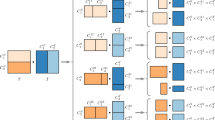Abstract
We study the problem of monotonicity testing over the hypercube. As previously observed in several works, a positive answer to a natural question about routing properties of the hypercube network would imply the existence of efficient monotonicity testers. In particular, if any set of source-sink pairs on the directed hypercube (with all sources and all sinks distinct) can be connected with edge-disjoint paths, then monotonicity of functions \(f:\{ 0,1\} ^n \to \mathcal{R}\) can be tested with O(n/∈) queries, for any totally ordered range \(\mathcal{R}\). More generally, if at least a µ(n) fraction of the pairs can always be connected with edge-disjoint paths then the query complexity is O(n/(∈µ(n))).
We construct a family of instances of Ω(2n) pairs in n-dimensional hypercubes such that no more than roughly a \(\frac{1} {{\sqrt n }}\) fraction of the pairs can be simultaneously connected with edge-disjoint paths. This answers an open question of Lehman and Ron [16], and suggests that the aforementioned appealing combinatorial approach for deriving query-complexity upper bounds from routing properties cannot yield, by itself, query-complexity bounds better than ≈ n 3/2. Additionally, our construction can also be used to obtain a strong counterexample to Szymanski’s conjecture about routing on the hypercube. In particular, we show that for any δ > 0, the n-dimensional hypercube is not \(n^{\tfrac{1} {2} - \delta }\)-realizable with shortest paths, while previously it was only known that hypercubes are not 1-realizable with shortest paths.
We also prove a lower bound of Ω(n/∈) queries for one-sided non-adaptive testing of monotonicity over the n-dimensional hypercube, as well as additional bounds for specific classes of functions and testers.
Similar content being viewed by others
References
Micah Adler, Nicholas J. A. Harvey, Kamal Jain, Robert D. Kleinberg and April Rasala Lehman: On the capacity of information networks, in: SODA, 241–250, 2006.
Nir Ailon and Bernard Chazelle: Information theory in property testing and monotonicity testing in higher dimension, Inf. Comput. 204(11) (2006), 1704–1717.
Ali Al-Bashabsheh and Abbas Yongaçoglu: On the k-pairs problem, CoRR, abs/0805.0050, 2008.
V. E. Benes: Mathematical theory of connecting networks and telephone traffic. New York, Academic Press, 1965.
Arnab Bhattacharyya: A note on the distance to monotonicity of boolean functions, Electronic Colloquium on Computational Complexity (ECCC) 15(012), 2008.
Arnab Bhattacharyya, Elena Grigorescu, Kyomin Jung, Sofya Raskhodnikova and David Woodruff: Transitive-closure spanners, in: SODA’ 09: Proceedings of the Nineteenth Annual ACM -SIAM Symposium on Discrete Algorithms, 932–941, Philadelphia, PA, USA, 2009. Society for Industrial and Applied Mathematics.
Arnab Bhattacharyya, Elena Grigorescu, Kyomin Jung, Sofya Raskhodnikova and David Woodruff: Transitive-closure spanners of the hypercube and the hypergrid. Electronic Colloquium on Computational Complexity (ECCC) 09(046), 2009.
Yevgeniy Dodis, Oded Goldreich, Eric Lehman, Sofya Raskhodnikova, Dana Ron and Alex Samorodnitsky: Improved testing algorithms for monotonicity, in: RANDOM-APPROX, 97–108, 1999.
Funda Ergün, Sampath Kannan, Ravi Kumar, Ronitt Rubinfeld and Mahesh Viswanathan: Spot-checkers, J. Comput. Syst. Sci. 60(3) (2000), 717–751.
Kevin Matulef Eric Blais, Joshua Brody: Property testing via communication complexity, To appear in Proc. CCC 2011, 2011.
Eldar Fischer: On the strength of comparisons in property testing, Inf. Comput. 189(1) (2004), 107–116.
Eldar Fischer, Eric Lehman, Ilan Newman, Sofya Raskhodnikova, Ronitt Rubinfeld and Alex Samorodnitsky: Monotonicity testing over general poset domains, in: STOC, 474–483, 2002.
Oded Goldreich, Shafi Goldwasser, Eric Lehman and Dana Ron: Testing monotonicity, in: FOCS, 426–435, 1998.
Oded Goldreich, Shafi Goldwasser, Eric Lehman, Dana Ron and Alex Samorodnitsky: Testing monotonicity, Combinatorica 20(3) (2000), 301–337.
Shirley Halevy and Eyal Kushilevitz: Testing monotonicity over graph products, Random Struct. Algorithms 33(1) (2008), 44–67.
Eric Lehman and Dana Ron: On disjoint chains of subsets, J. Comb. Theory, Ser. A 94(2) (2001), 399–404.
Anna Lubiw: Counterexample to a conjecture of szymanski on hypercube routing, Inf. Process. Lett. 35(2) (1990), 57–61.
A. Rasala-Lehman: Network coding, PhD thesis, Department of Electrical Engineering and Computer Science, MIT, Cambridge, MA, 2005.
Sofya Raskhodnikova: Monotonicity testing, Master’s thesis, Department of Electrical Engineering and Computer Science, MIT, Cambridge, MA, 1999.
Ted H. Szymanski: On the permutation capability of a circuit-switched hypercube, in: ICPP (1), 103–110, 1989.
Author information
Authors and Affiliations
Corresponding author
Rights and permissions
About this article
Cite this article
Briët, J., Chakraborty, S., García-Soriano, D. et al. Monotonicity testing and shortest-path routing on the cube. Combinatorica 32, 35–53 (2012). https://doi.org/10.1007/s00493-012-2765-1
Received:
Published:
Issue Date:
DOI: https://doi.org/10.1007/s00493-012-2765-1




